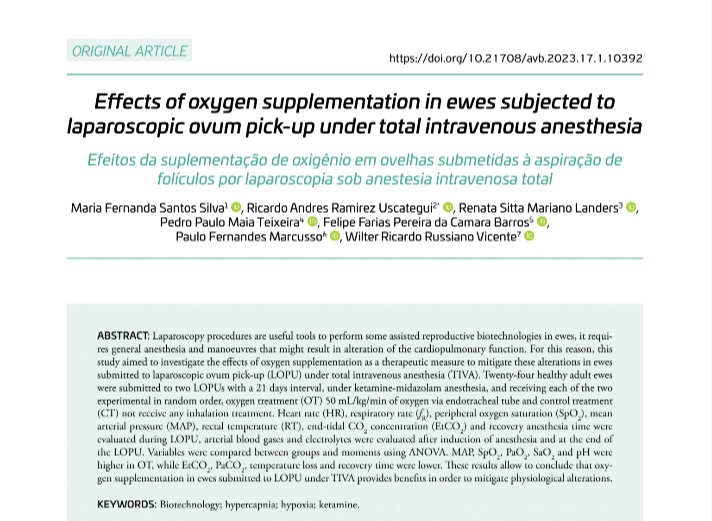Effects of oxygen supplementation in ewes subjected to laparoscopic ova collection under total intravenous anesthesia
DOI:
https://doi.org/10.21708/avb.2023.17.1.10392Resumo
Laparoscopy procedures are useful for the application of some assisted reproductive biotechnologies in ewes, it requires general anaesthesia and manoeuvres that might result in cardiopulmonary function alterations. For this reason, this study aimed to investigate the effects of oxygen supplementation as a therapeutic measure to mitigate these alterations in ewes submitted to laparoscopic ova collection (LOC) under total intravenous anaesthesia (TIVA). Twenty-four healthy adult ewes were submitted to two LOCs 21 days interval, under ketamine-midazolam anaesthesia, receiving each of the two experimental in random order, oxygen treatment (OT) 50 mL/kg/min of oxygen via endotracheal tube and control treatment (CT) not receive any inhalation treatment. Heart (HR), respiratory rate (fR), peripheral oxygen saturation (SpO2), mean arterial pressure (MAP), rectal temperature (RT), end-tidal CO2 concentration (EtCO2) and recovery anaesthesia time were evaluated during LOC, arterial blood gases and electrolytes were evaluated after anaesthesia induction and at the LOC end. Variables were compared between groups and moments using ANOVA. MAP, SpO2, PaO2, SaO2 and pH were higher in OT, while EtCO2, PaCO2, temperature loss and recovery time were lower. These results allow to conclude that oxygen supplementation in ewes submitted to LOC under TIVA provides benefits in order to mitigate physiological alterations.
Downloads

Downloads
Publicado
Edição
Seção
Licença
Copyright (c) 2023 Acta Veterinaria Brasilica

Este trabalho está licenciado sob uma licença Creative Commons Attribution 4.0 International License.
Autores que publicam na Acta Veterinaria Brasilica concordam com os seguintes termos: a) Autores mantém os direitos autorais e concedem à revista o direito de primeira publicação, com o trabalho simultaneamente licenciado sob a Licença Creative Commons Attribution que permite o compartilhamento do trabalho com reconhecimento da autoria e publicação inicial nesta revista. b) Autores têm autorização para assumir contratos adicionais separadamente, para distribuição não-exclusiva da versão do trabalho publicada nesta revista (ex.: publicar em repositório institucional ou como capítulo de livro), com reconhecimento de autoria e publicação inicial nesta revista. c) Autores têm permissão e são estimulados a publicar e distribuir seu trabalho online (ex.: em repositórios institucionais ou na sua página pessoal) a qualquer ponto antes ou durante o processo editorial, já que isso pode gerar alterações produtivas, bem como aumentar o impacto e a citação do trabalho publicado (Veja O Efeito do Acesso Livre).


 Esta obra está licenciada com uma Licença
Esta obra está licenciada com uma Licença 